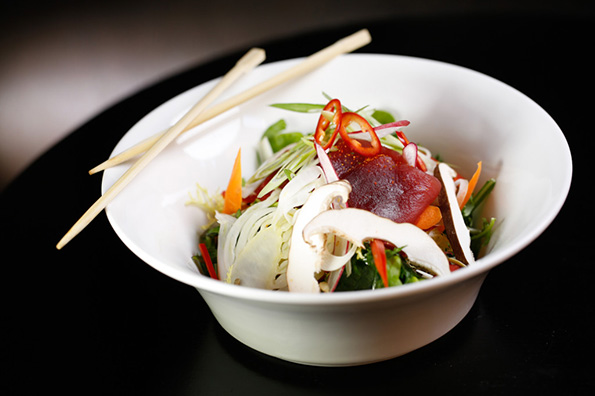
Bowls filled with a bunch of ingredients — usually good for you, and often topped with proteins such as chicken, steak or pork — have been popping up on menus everywhere in recent years. The popularity of this easily customizable, often nutritious and very portable dish has even spawned numerous bowl-centric restaurants. Now, many chefs are looking to make a good thing even better by tweaking the bowls with the addition of seafood.

“I like seafood because it’s clean and fresh,” said Troy Guard, chef and owner of TAG Restaurant Group. “I feel better when I eat cleaner, healthier bowls.”
At bubu, Guard’s build-your-own-bowl concept in Denver’s historic Larimer Square district, diners customize their bowl with one of six proteins — cold-poached tuna or salmon, chilled shrimp, grilled steak, chicken thigh or tofu — and then add five other items chosen from an expansive list of about 40 ingredients.
They can also opt for an already customized combination, such as the Hawaii Five-O, with tuna poke, white rice, crunchy bubu (a Japanese cracker), raw fennel, hearts of palm and soy-onion dressing. Seafood-topped bowls account for nearly 40 percent of bowl sales at the two-year-old-concept.
“People are really digging the raw aspect of the salmon and tuna,” said Guard.
Indeed, the concept is doing so well that a second location in the Lowry section of Denver is slated to open in September.
At Yona, a full-service noodle bar and Japanese small-plates restaurant in Arlington, Va., chef and partner Jonah Kim recently added to his lunch menu a broiled eel donburi (literally “bowl” in Japanese) with pickled burdock root, Japanese pepper, sesame seeds and eel sauce over rice.

“Rice, noodles, and pasta are comfort-food ingredients with diners nowadays,” said Kim. “Adding seafood to the rice bowls (noodles, pasta), is a great way to add lighter protein options to the dish.”
Kim previously put a chilled soba noodle bowl with tuna poke on the menu, and says he plans to continue to explore and add other seafood bowls to his menu.
Inspired by the popularity of a bowl he made for staff meals, chef Chris Emerling of The Bel-Air in Los Angeles recently added to his menu the BOH Bowl. The staff-meal-turned-main-menu dish features Savannah rice, epazote stewed black beans, sliced California avocado, pico de gallo, and a choice of either blackened salmon, shrimp or chicken.
“Seafood is the healthiest protein you can put in a bowl,” said Emerling “[Bowls are] fun and easy to eat, and it's casual. With seafood, it's all of the above plus amino acids.”
The BOH Bowl is selling so well that Emerling said he’s already “dreaming up” new seafood bowls.

On The Border Mexican Grill & Cantina, a Tex-Mex casual-dining chain with 150 locations, began getting on the bowl train last May 2015, when it first rolled out a line of the trendy dish. The Shrimp Border Bowl, made with lime-cilantro rice, black beans, veggies and salsa, and topped with a lime-cilantro chimichurri sauce, avocado slices and a skewer of mesquite grilled shrimp, is the chain’s second-best-selling bowl (chicken is, of course, tops).
"The Shrimp Border Bowl fits great into our bowl category,” said Brian Campbell, director of culinary research and development for On The Border. “I think the shrimp is especially appealing because it is such a light dish that you could eat every day and not feel guilty."
Similarly, Sharky’s Woodfired Mexican Grill, the better-for-you fast-casual chain with 24 locations in California, recently transformed its popular Wild Salmon Lite Burrito into a bowl. In March, the chain debuted the salmon bowl, which includes a grilled salmon filet, sautéed veggies and onions, organic rice, organic beans, guacamole, sour cream and pico de gallo.
Meanwhile, Santa Ana, Calif.-based Wahoo’s Fish Taco continues to have success with its Wild Alaskan Salmon Bowl, made with Polynesian grilled salmon, served on a bed of rice, citrus slaw mix and with side of homemade aioli sauce, introduced to its menu two years ago.
“We had to print up some special stickers during the first year because the demand outpaced our supplies,” said Renato “Mingo” Lee, co-founder of Wahoo’s. “It continues to grow as a category with all the news about the fish oils.”





